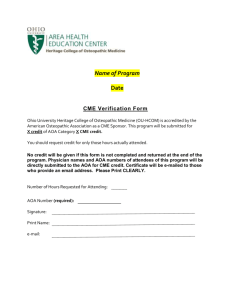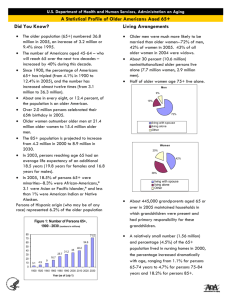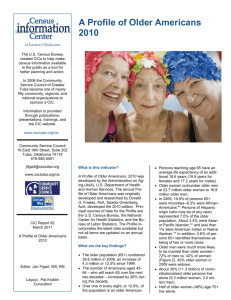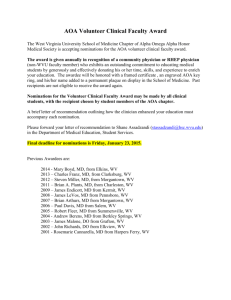The Aging P - City Tech OpenLab
advertisement
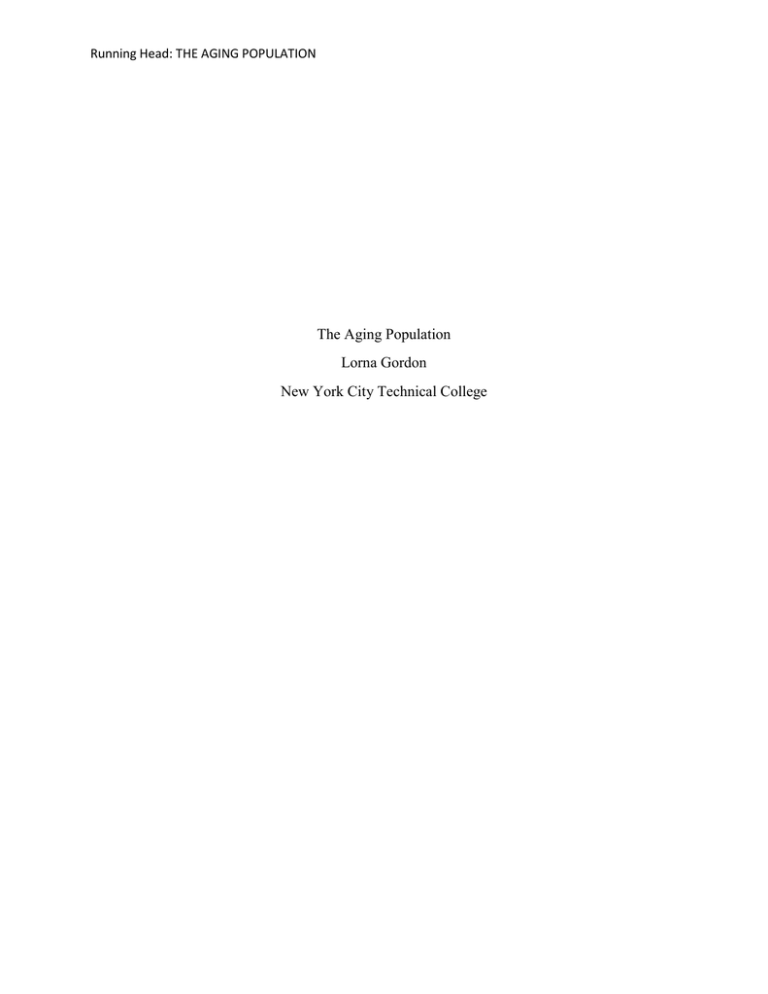
Running Head: THE AGING POPULATION The Aging Population Lorna Gordon New York City Technical College 2 THE AGING POPULATION The Aging Population Introduction The Administration on Aging (AOA, 2012) identifies older adults as individuals aged 65+. Older adults accounted for 41.4 million of the United States population in 2011 with older adult women accounting for 23.4 million of this population with men making up 17.9 million this population. The AOA (2012) further notes that this number is expected to grow considerably in coming decades. This paper explores issues and trends related to aging and the older adults addressing areas such as life expectancy, marital status, living arrangements, income, employment, health, accommodation, and geographical distributions. Question 1/ what are the issues older adults are confronted with as they advance in age? Advancement of age produces many challenges for older adults such as; ageism; the preconceptions and unfoundedly labels attached to the individuals due to their age (i.e. preconception that older adults are bad drivers or older adults are not dependable or useful) (Administration On Aging (AOA), 2012). In addition declining health produces self-care deficit; living arrangements that require acceptance of help or relocation to a suitable residence, financial instability; Isolation; loss of love ones, loss of autonomy and immobility are some of the issues older adults are confronted with as they advance in age (Eliopoulous, 2014). Question 2/ what are the current trends in life expectancy older adults can anticipate? Older adults can anticipate living a long life than was expected several decades ago. Epidemiologist report trends estimates the growth of the world wide population by the year 2050 will increase to 9.3 billion and about 4.5 percent will live in the United States with baby boomers (the surge in births between 1946 to 1964) accounting for the population surge of older adults is THE AGING POPULATION 3 the U.S. (Sade, 2012). People are living longer due to extended life expectancy or a general précis of the health of a population; it is the number of years a person is expected to live beyond a given age (AOA, 2012). Life expectancy trends points to significant disparities among older adults of differing race, ethnicity and sex (AOA, 2012). Question 3/ Marital status - What are the marital issues for older adults? Older adults are faced with several issues regarding marital status. Older adult women are more likely to be single whereas older adult men are more likely to be married. According to the AOA (2014) widows outnumber widowers. Additionally wives of older adults are often caregivers for their spouses (Eliopoulos, 2014). Question 4/ What are the current trends regarding marital status among the elderly? According to AOA (2012) divorce and separation percentages though low 12% has risen in the older adult populace compared to 5.3 % noted 20 years ago (AOA, 2012). Trends show that there is a scarcity of single older men with a significant amount of older men 73% being married compared to 42% percent of older women who are married. There is a scarcity of single older men. Widowhood also account for 37% of older adults (AOA, 2012). Eliopoulos (2014) purports that the increased amount of widowed older women is due to women marrying men who are older than they are, plus women already have a factor of living longer than men. Question 5/ Living arrangements – What are the issues for older adults? Living arrangements depends upon the physical and health status of older adults. The transition of accepting help is difficult for the older adult this is viewed as a loss of independence (Eliopoulos, 2014). Some older adults are unable to age in place due to health issues and lack of caregivers. THE AGING POPULATION 4 Question 6/ What are the current trends regarding living accommodations for older adults? The majority of older adults live at home in their own houses that are already paid for. Older adults are faced with financial difficulties of property taxes and repairs. Less than five percent of all older adults live in home care facilities, or nursing homes (AOA, 2012). Eliopoulos (2014) disclose that older adults are living independently for as long as they can do so with the help of home health services and family support. Also there is assisted living facilities for older adults that need minimal assistance this is a private pay service. Women tend to live alone more than men however, the likelihood of both sexes living alone increases with age. There are many places that accommodate older adults who cannot live independently. Meiner (2011) mentions that many losses associated with aging create frailty in older adults. Such conditions require skilled healthcare settings. Also mentioned is that safety and social needs should take priority when choosing housing for older adults. Question 7/ What are geographic issues concerning distributions of older adults in the U.S? Concerns exist regarding older adults accessibility to services, which can often be influenced by geographical distribution. Older adults tend to reside in or close to metropolitan areas notes Hartman and Wejerbach, (2013). Even though those residing in metropolitan areas often have services available to them as Konecny (2014) points out, older adults geographically located in both rural and urban areas experience difficulties/barriers due to transportation and socioeconomic status in accessing much needed health services. Additionally Hartman and Wejerbach (2013) notes 20% of America’s older adult populace reside in rural areas. Geographical distribution limits many older adults residing in rural areas access to critical services often due to lack of service and or lacking transport in order to access services. Question 8/ Current trends regarding geographic distribution of adults in the United States? THE AGING POPULATION 5 Distribution of Older Adults in the U.S.: It is reported that older adults comprise 13.1% of the American population (Hartman & Wejerbach, 2013). According to the U.S. Census Bureau (2011) trends in older adults in older adults geographic distribution show that older adults are widely dispersed throughout the U.S. The state of California has the largest number (3.3 million) older adults. Other states with large older adult population include but are not limited to Pennsylvania, New York, Illinois, New Jersey and Ohio. Florida is noted as also having a large number of older adult but in addition to a large number Florida is reported as having the highest percentage (19%) of older adults (U.S Census Bureau, 2011). Geographically the importance of Florida as a retirement haven for older is undeniable whether due to climate, benefits, and or security. The Florida Legislature’s Office of Economic and Demographic Research forecasts that “adults over 60 will represent 55.2 percent of Florida’s population growth of 5.1 million between 2010 and 2030. Florida will thus continue to age faster than the rest of the nation and 24.1 percent of its population will be 65 and older in 2030” (Bureau of Economic and Business Research, 2014). Question 9/ Income and Employment-What are the issues for older adults? The American Psychological Association (2014) reports that a main issue faced by older adults concerning employment is that choices are limited for this group who are often undervalued by society. Upon retirement, many older adults are placed at significant greater risk due to cost of living and low SES causing them to leave on fixed incomes. The American Psychological Association (2014) also notes that regardless of race women are likely to be at the greatest disadvantage concerning income and employment. According to the AOA (2012) older adults (86%) identified Social Security as their primary source of income and 3.6 million (8.9%) older adult register below the poverty level. It is important to note that Supplemental Poverty THE AGING POPULATION 6 Measures (SMP) looks at factors such as cost living, non-cash benefits received, and discretionary expenditures measure found that older adults at a poverty level of 15.1% an increase that is attributed to an area that is of great concern to many older adult, medical out-ofpocket expenses. Lack of income and employment for older adults affects their overall health/medical, access to quality housing and their quality of life. Question 10/ What are current trends in employment and income for older adults? The reported trend in income earnings found that the median income of older adult males was $27,707, $15,362 for females and $48,538 for homes where the primary earner was 65+ (AOA, 2012). The median income reported points to a significantly lowered SES for older adults. Coughlin (2007) reports that many of those identified as members of the “boomer generation” are retiring while others are yet opting to remain in the workforce that will ultimately change workforce makeup in the coming years. Coughlin (2007) and Jacobsen, Mather, Lee and Kent (2011) note that older adult percentages in the workforce have risen significantly in the past three decades. In 2019 older Americans are expected to make up 25% of the U.S workforce a huge jump from 1999 when older adults made up only 12% of the U.S. workforce (Jacobsen, et al, 2011). Question 11/ Education – What are the issues for older adults? Issues for older pertaining to education include demographics, physiological, physical, structural and structural issues as well as others (ACE, 2008 & AOA, 2014). Demorghic /physiological factors such as age often brings more responsibilities later in life and cognitive changes related to mental process such as memory (AOA, 2014). Physical issues that affect older adults and education may be related to hearing impairment in visual changes (AOA, 2014). Race also plays a factor regarding older adults and education studies have shown that non-white THE AGING POPULATION 7 older adults are not as likely to pursue education due to responsibilities such as caregiving for family member, poor health and low educational attainment throughout their lives (Jacobsen et al, 2011). Jacobson et al, (2011) as notes funding, and transportation are also noted issues concerning older adults and Question 12/ What are the trends in education for the older adult? Jacobson et al, (2011) states According to the American Council on Education (2008) due to many older adults expectations concerning a longer stay in the workforce some older adults are returning to school and achieving post-secondary educational objectives as well as receiving cross training in varying fields (ACE, 2008). Trends show that older adults are enrolled in part-time degree diploma programs, work related courses and personal interest courses (Jacobson et al, 2011). Though trends show enrollment it is important to note as Jacobson et al, (2011) point out that the studies being done primarily looking at white middle-class and more affluent older adults. There needs to be more evidence-based research that looks at old adults across a broader spectrum regarding education. Question 13/ Health issues –What are the issues for older adults? Health issues faced by older adults are numerous and includes physiological problems associated with aging , physical problems associated with aging and mental health as well as mental processes changes related to aging (AOA, 2014). AOA (2014) also notes that SES, race/ethnicity and culture all may also be influencing factors concerning older adults and health issues. Eliopoulos (2014) mentions some aliments that emanate with aging, as sensory deficit as in memory loss, hearing and vision problems digestive problems, heart failure, renal disease, vascular problems, diabetes, hypertension, and immobility. THE AGING POPULATION 8 Question 14/ What is the current health trend noted in today’s senior citizen? Current health trends show many older adults are diagnose with and expire as a result of heart disease, cancer, cerebrovascular disease, pneumonia/flu, and chronic obstructive pulmonary disease (AOA, 2014). Trends show that older minority adults are an increasing group in the U.S. populace, moreover there are noted differences between minorities and White regarding health issues. When compared to their white cohorts, minority older adults exhibit early chronic illness onset, prevalence of obesity, underreporting /delayed treatment seeking regarding health issues; lack of representation during drug studies are all trends noted regarding health issues/trends in minority populations (AOA, 2014). Multiple factors also contribute to poor mental health amongst older minority adults factors include unemployment, stereotyping, discrimination, poor education, poverty, and an overall lack of resources (AOA, 2014). Many older adults AOA (2014) notes are taking advantage of primary prevention, wellness promotion, education, and health maintenance resources such as the influenza, and pneumonia vaccine, exercising, healthy diet, life style changes, health monitoring, as well as socializing with family and friends in order to maintain wellness and prevent the advancement of illness. 9 THE AGING POPULATION Reference American Council on Education. (2008). Framing the new terrain: older adults & higher education. Washington DC: American Council on Education. Administration on Aging. (2012). A profile of older Americans: 2012. Retrieved from http://www.aoa.gov/AoARoot/Aging_Statistics/Profile/2012/2.aspx Administration on Aging. (2014). Older adults' health and age-related changes. Retrieved from http://www.aoa.gov/AoARoot/Aging_Statistics/Profile/2012/2.aspx American Psychological Association. (2014). Fact sheet: age and socioeconomic status Retrieved from http://www.apa.org/pi/ses/resources/publications/factsheet-age.aspx Bureau of Economic and Business Research. (2014). Boomers or bust in Florida and the nation. Retrieved from https://www.bebr.ufl.edu/articles/boomers-or-bust-florida-and-nation Coughlin, J.F., (2007). Are you ready for the new older workplace? aging baby boomers & the evolving role of employers (AgeLab 07-03). Cambridge, Massachusetts: Massachusetts Institute of Technology. Eliopoulos, C. (2014). Gerontologic Nursing 8th ed. Philadelphia: Lippincott Williams & Willikns Hartman, R.H., Weierbach, F.M. (2013). Elder health in rural America. Retrieved from http://www.ruralhealthweb.org/index.cfm?objectid=B7ABCFBB-3048-651AFE460BC204622FD9. THE AGING POPULATION Jacobsen, L.A., Mather, M., Lee, M., and Kent, M. (2011). American aging populations. Population Bulletin 66(1). Konecny, L. (2014). Attitudes about aging. PowerPoint Lecture. New York City College of Technology of The City University of New York. Meiner S. (2011), Gerontologic Nursing, 4th ed. Philadelphia Mosby U.S. Census Bureau (2011). Sixty-five plus in the United States http://www.census.gov/population/socdemo/statbriefs/agebrief.html 10
